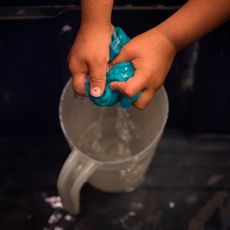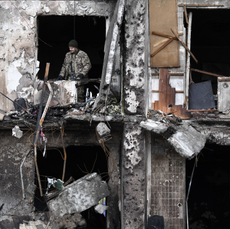For These Ukrainian Women, Their Weapons Are Their Smartphones
By collecting cell phone video straight from the front lines, Dattalion shows the unfiltered horrors of the war.


On the fourth night of the war, Mariya* was sleeping in a bomb shelter in Western Ukraine with her two kids when she woke up to her phone ringing. It was a friend calling from outside Ukraine—the friend was distraught over what she’d just seen on TV: a reporter interviewing someone in a relatively safe part of the country calmly explaining their plans for when and how to evacuate when things got bad.
But in Kyiv, which Mariya (who is using a pseudonym to protect her privacy and safety) had just fled, the bombs were already raining down from the sky. People were already being killed. The war was already there. Mariya and her friend felt the extent of that horror wasn’t being broadcast around the world.
Mariya talked to other women she knew all over the country (and to those who had escaped) and they made a plan: Their weapons would be information. With this war, it has been the devastating images of civilian injuries and death that have raised awareness of the reality inside Ukraine—just last week, President Joe Biden accused Russian President Vladimir Putin of war crimes and called for increased sanctions against the country after images of mass civilian casualties in Bucha were made public.
On February 24, Mariya and her friends launched “Dattalion”—a combination of the words “data” and “battalion.” It is a free and open database of video and still footage from on-the-ground battle zones. The group of more than 100 volunteers is mostly women and mostly Ukrainians.
Many of the volunteers—including leaders in government, business, sports, and the arts—are wives and mothers who, after ushering their children to safety, went back into Ukraine's areas of conflict to document the atrocities committed by Putin and the Russian military.
So far, they’ve collected and distributed some 1,700 smartphone videos and photographs from the front lines—there are images of bombed-out buildings, groups of children huddled together, and captured Russian soldiers. The videos, many of which are graphic, are submitted by people the group calls “citizen journalists,” as well as obtained from private social media accounts and Telegram channels.
There is one major caveat regarding the footage: The volunteers who source and post aren’t trained journalists, and much content sent in anonymously. When it comes to verifying the footage, the group says it is constantly working to ensure the authenticity of photos and videos based on dates and locations, but didn't share specific methods for doing so. The database is available to be used by reporters, politicians, celebrities, documentarians—anyone with a platform, which they hope will, in turn, enact real change
Stay In The Know
Get exclusive access to fashion and beauty trends, hot-off-the-press celebrity news, and more.
Here, we spoke with Mariya, who has continued to build Dattalion from where she is now staying in the E.U., about joining the fight against Russia.

An image captioned in the Dattalion database: "After liberation of Trostyanets [a city in Ukraine's Sumy region] from Russian occupiers, citizens say that Russian military shot civilians in the streets, took food, tortured."
Marie Claire: How did you mobilize so quickly?
Mariya: I live in Kyiv and when there was this potential threat, I got my kids to Western Ukraine to my mom and I got back to Kyiv to work. And then when the first few bombs started, I was lucky to escape the city in the first wave. I took only one suitcase and my pets.
I spent the next three days in Western Ukraine, trying to figure out how I can help. My husband stayed in Kyiv working as a volunteer doing everything from evacuating kids from occupied cities to helping organize military supplies. I’m saying to him, "What can I do in order to help us to win this war?"

A Dattalion photograph of a 7-year-old selling flowers to raise money to buy armor for Ukrainian soldiers.
Within a few hours, we were brainstorming with a number of foreign journalists. We asked them what we could do for foreign media to show what's really going on in Ukraine. We came up with the idea of creating a witness video database, where we take videos from social media and different public sources and group them, name them, tag them, and write descriptions. From that call to the moment when we started collecting data, it took us 24 hours. I had a team of 10 volunteers working on the project and we gave video access to those journalists who were brainstorming with us. Initially, the database was only upon request because we were not ready with all our security precautions.
Our weapon is the truth—videos and photos in our database that reveal what is happening.
Then, we grew to 25 people in two days. We had CEOs to CFOs to interns working all together and growing the project, some here and some from abroad. It has all grown through social media. I just asked people, "Who is ready to volunteer?" and then we would get 20 more. Today, we have about 120 volunteers, the majority are Ukrainians, about half in and half out of the country. We also have foreign volunteers all over the world.
Almost all our core team and volunteers are women. There are two reasons for that. First, men are fighting. The second, men [and some women] are doing more dangerous things like evacuating kids, working as a drivers, bringing humanitarian aid, etc. Because we are women, we are very resilient and eager to work 24/7 because we are working not only for us, but we're working and fighting for our kids, and for our kids not yet born, and for our mothers and sisters.
If you look at the content of these videos—if you watch them for more than an hour, I mean, you couldn't sleep. I promise, I've done it and it's... now I'm only watching videos every third day because I just can't work.
MC: When you watch, it overwhelms you?
Mariya: It overwhelms anybody. But it's not only about people suffering, but it's also [emotional] when I see kids who are [still] over there. If I see Ukrainian soldiers, what they are doing, how they are risking their lives. Or if I see, for example, bombs hitting a historical building or the place where I first kissed someone and there is no bench or building anymore. If I watch videos from cities or places where my friends live or used to live, and I know my friends are there and I can’t reach them.

The Dattalion founders created a free database of photos and videos taken from Ukraine's war zones.
MC: How do you get the videos? Do your people, your teams come to you and say, "There's going to be a demonstration, we want to go," or do they just go and film it and upload it to the site?
Mariya: It works different ways. We cannot tell people where they need to go because we do not want to put them in a dangerous situation, no way. We are [uploading] the video that people have already filmed and posted. People send them anonymously.
We [upload] videos and put in the location names, dates, and tags. We have four [main] audiences we work for. The first one is media, because we believe that if one person posts a video on social media, only 2,000 or 5,000 followers see it. If it's broadcast on NBC or whatever, then it will have millions of people seeing it.
The second audience is politicians or decision-makers in foreign countries. Because they want to have a second source of information and, quite often, they do not see the full picture when they read reports [in the] paper.

A Dattalion photo captioned in the database, "This is what the hospital looks like, where people rescued from Mariupol are brought."
The third group is celebrities and opinion leaders, because they are the ones who share video content. And so, quite often, if they still have not decided what their position would be or what type of assistance or aid they should provide, our videos are very instrumental in convincing them how they should help.
The fourth group of people are working on documentaries, films, and the arts.
We are not government affiliated in any way; we are independent, but we provide the Ukrainian government with access to our data and access to all the files because they use it in their communication. Also, they can use it as evidence in cases against Russia in international courts. The audience just grows somehow; we are not tracking it, but to give you an idea, usually in a day we have from 2,000 to 6,000 videos being downloaded.
We are growing naturally. Now in the U.S., we’ve started a campaign in Congress, which is called What Is the Red Line, asking them to provide more military and economic support to Ukraine and close the air spaces, creating a no-fly zone. We are, as mothers, showing those videos, saying, "Look! Look how many kids have been killed already. Look how many buildings were destroyed."

The Dattalion images are available to journalists, politicians, celebrities—anyone willing to spread awareness about the atrocities being caused by Putin's Russian army.
MC: Have you heard of anyone in Russia using it? Can they access it?
Mariya: Yeah, they can see it. We provided our database to all Russian independent media, and our database is public [now]. I think many Russians are brainwashed, and we are not focusing on them at the moment because I'm not sure they are our target audience.
MC: Right now, what is you primary objective?
Mariya: Our goal is to help to stop the war in any way we can; whatever it takes to be instrumental in stopping the war. Now, we see that we need [to create no-fly zones], so we are providing our videos for those campaigns.
They're bombing hospitals, they're bombing shelters, they are bombing schools. And every second, one Ukrainian child becomes either an IDP [internally displaced person] or a refugee. Every second.
Our weapon is the truth—videos and photos in our database that reveal what is happening.
MC: Are you afraid of being attacked for what you are doing?
Mariya: For me, it's not even about the physical threat because now I'm in the E.U. and I feel safe. It's more about cyber threats. Through me or through any member of our team, [cyber attackers] can get to the database. Every day, I have an unauthorized attempt to access my social media and my email. I cannot go public because, through me, they can get to the database.
MC: Thank you for sharing this. Be safe and good luck.
Mariya: I'm saying to everybody, let's celebrate when we win. I mean, I want to see all the people that we talked to at a big party. At a big party in Ukraine.
This interview has been edited and condensed for clarity.
Maria Ricapito is a writer who lives in the Hudson Valley.
-
 'Missing You' Includes a Surprise Cameo From One of the U.K.'s Biggest TikTok Stars—Here's What to Know About GK Barry
'Missing You' Includes a Surprise Cameo From One of the U.K.'s Biggest TikTok Stars—Here's What to Know About GK BarryThe influencer, whose real name is Grace Keeling, makes her acting debut on the new Netflix thriller series.
By Quinci LeGardye Published
-
 The Nod to Princess Diana You Might Have Missed in Meghan Markle's Netflix Trailer
The Nod to Princess Diana You Might Have Missed in Meghan Markle's Netflix TrailerThe Duchess of Sussex kept one of Diana's belongings close throughout the series.
By Kristin Contino Published
-
 Jennifer Lawrence Anoints the First It Shoe of 2025
Jennifer Lawrence Anoints the First It Shoe of 2025It's from The Row, of course.
By Halie LeSavage Published
-
 How New York's First Female Governor Plans to Fight for Women If Reelected
How New York's First Female Governor Plans to Fight for Women If ReelectedKathy Hochul twice came to power because men resigned amid sexual harassment scandals. Here, how she's leading differently.
By Emily Tisch Sussman Last updated
-
 My Family and I Live in Navajo Nation. We Don't Have Access to Clean Running Water
My Family and I Live in Navajo Nation. We Don't Have Access to Clean Running Water"They say that the United States is one of the wealthiest countries in the world. Why are citizens still living with no access to clean water?"
By Amanda L. As Told To Rachel Epstein Published
-
 "It Is Hell."
"It Is Hell."Marie Claire Ukraine staffers on what they’re enduring as bombs fall on their beloved country.
By Galia Loupan Published
-
 Clarissa Ward on What It's Really Like to Report Live From Ukraine Right Now
Clarissa Ward on What It's Really Like to Report Live From Ukraine Right NowThe network's chief foreign correspondent on pivoting from Kabul to Kharkiv and Kyiv.
By Maria Ricapito Published
-
 Senator Tammy Duckworth Doesn't Want Her Daughter's Birth to Be News Anymore
Senator Tammy Duckworth Doesn't Want Her Daughter's Birth to Be News Anymore"It says something about where our country is, especially in relation to other developed industrialized nations, that this is such big news."
By Kayla Webley Adler Published
-
Dispatch from Afghanistan: Imprisoned Women and Ill-Fitting Bullet-Proof Vests
Still, it's not all bad news from the war front.
By Karen Day Published
-
 A Soldier's Tale: Lynndie England
A Soldier's Tale: Lynndie EnglandShe's the face of the atrocities at Abu Ghraib. Now serving 36 months in military prison, Lynndie England breaks her silence about what happened in Iraq, and how it all started with falling for the wrong man.
By Tara McKelvey Published
-
 "Why I Went AWOL"
"Why I Went AWOL"She defends her decision to flee.
By Tamara Jones Published